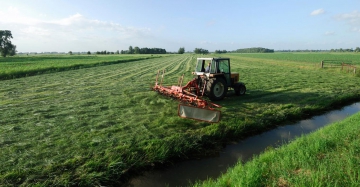For food and beverage companies, water is the foundation of their business. And in the face of climate change, and increasing water scarcity and quality issues around the globe, many companies are doubling down on their water stewardship efforts to secure their business, and the communities and ecosystems they operate in.
However, we’ve reached a point where traditional water stewardship practices such as reducing usage and enhancing efficiency are no longer enough. Why? Because traditional tactics often focus on activities at the facility level—rather than the broader watershed/community, across the whole value chain, and beyond.
Now, it’s important to note there are exceptions. In fact, a variety of industry leaders are pushing beyond their facilities, and looking at watershed context, their supply chains, and future scenarios. Look no further than the incredible water work being done by members of the Beverage Industry Environmental Roundtable (BIER). But despite the progress being made, there’s little doubt that more needs to be done.
Antea Group and our global partners have remotely screened more than 26,000 facilities around the world for water-related risks and opportunities, and conducted over 400 on-the-ground watershed assessments. This experience, along with data from third-party research, has led to formulation of three data-driven insights every food and beverage company needs to know if they want to propel water stewardship to the next level—and bolster their business for the long-term.
Insight 1: A holistic approach to water stewardship is of paramount importance
There’s no question that traditional water stewardship practices for direct operations are an absolute must. Reducing water usage, improving efficiency and boosting reuse are part of the foundation of any water strategy – the ‘walk-the-talk’ of water stewardship.
But if you want to advance your water stewardship efforts and achieve meaningful business value, you need a holistic approach. This means better understanding the local watershed and evaluating location-specific water needs, risks and opportunities for your operations and raw material sourcing. This insight is then used to develop and implement a proactive water strategy that addresses both short- and long-term issues and goals. Ultimately, every company should pursue a more holistic water strategy that covers direct operations to telling your water story such as the Act – Engage – Influence framework developed by the beverage sector.
To put things into perspective, under the existing climate change scenario, almost half of the world’s population will be living in areas of high water stress by 2030, according to the United Nations. This not only means that water availability at your facilities could become an issue, but across your agricultural supply chain, too. In addition, this could trigger new local policies, spikes in costs and community unrest—all of which can directly impact your business.
Insight 2: Performance in watershed context matters
As stated above, a holistic approach to water stewardship requires the evaluation of location-specific water needs, risks and opportunities. And that’s where performance in watershed context comes in.
Simply put, when it comes to measuring the effectiveness of water stewardship initiatives, conventional water metrics such as water use efficiency are not enough. Of course, you need to understand how much and how efficiently your facilities use water to get baseline performance data. But those metrics often don’t account for local watershed size, structure and demographics—making it difficult to understand your true water risks and local impacts and dependencies. In other words, volumetric water footprints only provide limited insight unless associated watershed context information is considered. Think of this as the volume being the foot ‘size’ and the impact being the foot ‘print’.
For example, the local watershed context for a facility in a waterfront city like Vancouver is wildly different from that of a facility in Nairobi, Kenya. But each facility faces water-related challenges that could impact your business.
For Vancouver and its metro area, a recent study is predicting that climate change will warm temperatures about 3 degrees Celsius (roughly 37 degrees Fahrenheit) by the 2050s. This means big changes for the ecosystem and more extreme weather events—all of which will impact the local watershed and businesses. In addition, the population of the metro area is rapidly growing, which will absolutely impact water resources.
As you can see, local context based on current conditions and trends lends important perspective to the unique water risks facing your organization now and into the future.
Insight 3: Water stewardship isn’t the end game—it's water security
After more than three decades of water and sustainability consulting, Antea Group sees water security as the necessary next step in water stewardship. For us, it’s another critical piece of developing a holistic water strategy.
At its core, water stewardship is all about being a better water user and minimizing impacts on local watersheds. Water security, on the other hand, aims to safeguard sustainable water access, availability and quality for all—and that requires collaboration, future planning and looking beyond what you can “control” for the benefit of future generations and long-term business resiliency.
For those companies that are already looking beyond their facilities, they’ve made some critical steps toward better water security. But there is still opportunity and critical leadership needs to help tackle systemic issues facing watersheds.
For example, aging or structurally deficient water infrastructure needs attention. Through our watershed studies, we’ve found that anywhere from 20 to 40% of non-revenue water (NRW) is lost in distribution due to leaking or illegal tapping. According to a Public – Private Infrastructure Advisory Facility (PPIAF) paper, NRW represents an opportunity cost not only for the utility provider, but also for cities, the environment and the broader economy.
“In general, reducing NRW leads to fewer service interruptions, more continuous supply, higher pressures, and cleaner water,” the report states.
The bottom line here? Food and beverage companies have an opportunity to work with local utilities, governments, and other local stakeholders to make improvements and policies that will lead to better water security for all and achieve demonstrable results towards water security than current stewardship actions can achieve.
The Data Challenge
Over the years, we’ve consulted with a wide range of companies inside and outside the food and beverage sector. Oftentimes, we find that having the right internal data and access to external data—especially about local watersheds—is a huge barrier.
The good news is there are a number of helpful tools and resources available. The CEO Water Mandate has a water stewardship resource hub featuring toolkits, frameworks and practical papers. In addition, BIER also offers several great tools, such as the True Cost of Water Toolkit.
However, you also need to seek data out. When it comes to local watersheds, get in touch with local municipalities to gather information about water quality and demand, or partner with a consultant for an on-the-ground assessment. In addition, consider investing in data-sharing partnerships with other industry peers or relevant third-parties. While you may feel like some of these actions are out of scope, everyone has a vested interest in better water stewardship and long-term security.
At the end of the day, water is a shared resource and data is vital for identifying and understanding risks that will unlock opportunities for bolstering your water strategy, building future proof businesses and making communities more resilient and sustainable.
Learn how Antea Group and our partners have helped companies tackle water risks and water stewardship to strengthen their sustainability commitments and make lasting change.
Want more news and insights like this?
Sign up for our monthly e-newsletter, The New Leaf. Our goal is to keep you updated, educated and even a bit entertained as it relates to all things EHS and sustainability.
Get e-NewsletterHave any questions?
Contact us to discuss your environment, health, safety and sustainability needs today.






